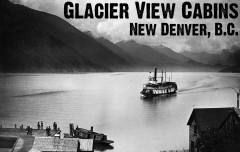
The Nikkei Internment Memorial Centre (NIMC) in New Denver is the only interpretive centre in Canada dedicated to the history of the uprooting and internment of over 22,000 Canadians of Japanese heritage. The Centre consists of five buildings, three of which are the old original huts or shacks that were built in 1942 to accommodate the displaced citizens. Inside two of the huts you will see the furnishings and stoves that were actually used by the occupants. At times two families occupied one hut, one family on either side of a common kitchen. Toilet facilities, rows of outhouses, are also preserved. The large central hall displays pictures , texts and equipment of tents, desks, boxes and other luggage used in their journey to the various campsites from the coast. There are a few citizens still living in New Denver from those originally resettled here in 1942






1 comment:
Hello, thank you for doing the write up. I am glad to be able to read something about the museum from the town of New Denver, and have been there several times. Congrats on the National Historic Site designation as well.
I noticed your use of the word 'hut' to describe the dwellings built for the internees. Perhaps out of respect for the former residents, you could rephrase this to 'house' as this is what they were. The Japanese men were ordered to build them and I think they would also take objection to this description.
Second, being made from timber, with four walls, a gable roof, and glass windows, even though the living conditions were still unbearable as there was literally no insulation for these mostly coastal people, 'house' would be a more accurate description.
Finally, hut - conjuring up a pit-dwelling, a shelter or home put together by free people of their own determination and volition and experience with the environment implies a context of internment that is historically and politically inaccurate. The builders were tragically unfamiliar with the mountain climate, again being mostly displaced coastal people. But even if they had been, they were not free to determine the best suited housing for the environment. These were dwellings designed by the government and built by Japanese men who were essentially working as prisoners.
I hate to argue over words, but words were one of the primary weapons used to fashion and justify the internment. I believe that you will want to incorporate this understanding into the way this blog writes about it.
Thank you,
Kenji
Post a Comment